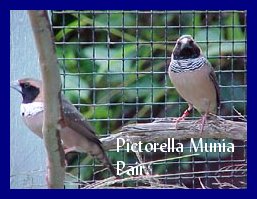| David Pace's Pictorella manual (page 2). Pictorella Mannikin Heteromunia pectoralis ASMP Category 4 IUCN Category - not listed. The Pictorella Mannikin has recently been recorded as being susceptible to Air Sac Mite, Sternostoma tracheacolum, with an estimated 62% of the wild population being affected (ANCA '95). Garnett lists the Pictorella Mannikin in Taxa of special concern, proposing that overgrazing, particularly of rank grass along watercourses and the increase of late dry season burning, as possible threats to this species, which is not yet threatened but should be monitored (Garnett '92). Band size and special banding requirements No. 3 size Australian Bird Banding Scheme plastic colour band. Sexing Adults: Sexes are similar, however females have broader and narrower white barring on the breast, with more black on the breast visible. Males' white barring is less defined and thicker, covering most of the breast. Immatures: Young lack any of the white colouration and are a general dark brownish to grey, being a little lighter on the underparts. The bill is brown black and the black face is evident (Shephard '89 & Immelmann '65). Adult weights and measures length: 109 - 120mm wing: 58 - 62mm tail: 35 - 41mm bill: 13 - 14.7mm tarsus: 14.4 - 16.2mm weight: 13.5 - 15g (Rowland '96) Picture opposite. Pictorella Pair Male on left. Natural History 1.1 Distribution The range of the Pictorella fluctuates due to its nomadic nature. This species occurs in northern Australia, from the Kimberley range, Western Australia, to Normanton and Cloncurry, Queensland (Rowland '96). Garnett suggests that the distribution of this species may have contracted in northwestern Queensland, however the Pictorella is still widespread between Cape York Peninsula and the Kimberley region of northwest Australia (Garnett '92). Garnett lists the Pictorella in Taxa of special concern, proposing that overgrazing, particularly of rank grass along watercourses and the increase of late dry season burning, as possible threats to this species, which is not yet threatened but should be monitored. Garnett does concede that the Pictorella is still numerous in areas that have been grazed for over a century (Garnett '92). 1.2 Habitat The Pictorella has adapted to arid life better than any other mannikin (Rowland '96). The average temperature of their range varies from 20? C through to 40?C. The annual rainfall throughout their range is between 400mm and 1000mm (Kingston '94). The Pictorella inhabits open grassy plains that are sparsely dotted with acacia. They prefer to remain in the vicinity of creeks and waterholes, but can be located far from any surface water. Immelmann describes how F. L. Whitlock observed birds in the western Kimberleys in true Spinifex country, a habitat typical for the Painted Firetail Emblema pictum (Immelmann '65). 1.3 Habits Pictorellas, being nomadic, can suddenly arrive in places where they have not been observed for years and disappear just as quickly. During the wet season Pictorellas can be scattered throughout their entire range, coming together in flocks of up to several hundred in coastal areas during the dry season, where they can be seen with Chestnut-breasted Lonchura castaneothorax and Yellow-rumped Lonchura flaviprymna Mannikins (Immelmann '65). When in large flocks, the Pictorella usually maintains only loose aggregations and lacks any strong social structure. Pictorellas, unlike other Australian grass-finches, do not indulge in mutual preening (Queensland Finch Society '87). During the breeding season they are usually found in pairs or in small flocks of up to 12 individuals (Rowland '96). The nomadic nature of the Pictorella was documented early in the twentieth century when Rowland, quoting a remark by Frederick Berney to Gregory Matthews stated, "This is an uncertain visitor. One year or another I have seen them during all four seasons, but they generally pick the good times." (Rowland '96) 1.4 Feeding Behaviour Pictorellas tends to drink only once or twice a day, where they drink water through sipping in rapid succession. This is done much faster than most finch species, minimising the risk of exposure to predation at an open waterhole (Rowland '96). Russell Kingston witnessed a remarkable incident in Broome, Western Australia, when a small group of Pictorellas landed on a beach, moved to the water's edge and proceeded to drink seawater! Can Pictorellas survive during times of drought by drinking salt water? (Kingston pers. comm.) Pictorellas, like other grass finches, are able to climb up and down grass stems in search of seed, however they are usually observed feeding on the ground. The diet consists of fallen and half-ripe grass seeds, supplemented by invertebrates during the breeding season, such as spiders, beetles and in particular, flying termites (Immelmann '65). |
 |